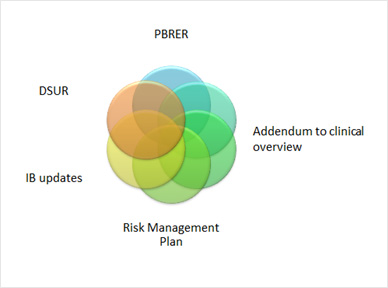Periodic Benefit Risk Evaluation Report (PBRER) provides a periodic, comprehensive, concise, and critical analysis of new or emerging information on the risks of the medicinal product, and on its benefit in approved indications, to enable an appraisal of the product’s overall benefit-risk profile. Guidelines are available from International Council for Harmonisation (ICH) Topic E2C (R2) and EU Good Pharmacovigilance Practices (GVP) – Module VII.
Such reports are required because the data from clinical trials based on which the product was approved tend to be short duration and with limited number of patients in a controlled environment. Often, higher risk patients with concomitant illnesses that require use of other drugs are excluded from clinical trials, and long-term treatment data are limited. PBRER is intended to harmonise the periodic reporting requirements to regulatory authorities and to provide, in a common format, the worldwide interval safety experience of a medicinal product at defined times post-approval. The frequency of submission of reports to regulatory authorities is subject to national regulatory requirements.
One report is submitted for one active substance. It should provide information on all approved indications, dosage forms, and regimens. Evaluation of new information relevant to the medicinal product that became available to the marketing authorization holder (MAH) during the reporting interval, in the context of cumulative information is done by
- Summarising relevant new safety information that could have an impact on the benefit-risk profile of the medicinal product
- Summarising any important new efficacy/effectiveness information that has become available during the reporting interval
- Examining whether the information obtained by the MAH during the reporting interval is in accordance with previous knowledge of the medicinal product’s benefit and risk profile
- Where important new safety information has emerged, conducting an integrated benefit-risk evaluation for approved indications
PBRER has been developed to follow a modular approach. For example, if the Development International Birth Date (DIBD) of a Development Safety Update Report (DSUR) for a medicinal product is aligned to the International Birth Date (IBD) of the PBRER for the same product as suggested in ICH E2F, the content of a number of sections of the DSUR can also be used in the PBRER when the Data Lock Points (DLPs) are the same.
There is lot of planning, collaboration, and best practice involved in the development of PBRER, few of which are listed below:
- Development of relevant training materials, guidelines to support teams in their preparation of quality PBRER documents
- Standardised procedure and data delivery plan before a kick-off meeting
- Methodology for comparative benefit-risk methodology
- Standardised PBRER language be developed as model document templates
- Recommendations for the project management plan template which include roles, responsibilities, timelines, major considerations, information sources, milestones and a detailed kick-off agenda
- If the reporting interval is more than one year, conducting a separate clinical benefit-risk sections kick off meeting
- Collaborative guidelines for responsibilities and inputs from regulatory, safety, medical and clinical science members
- Frontloading as much as possible, including literature data summarization before the DLP
- Use of harmonized data lock points and modular approach
- Continuous improvement, being proactive and adhering to the stringent timelines








